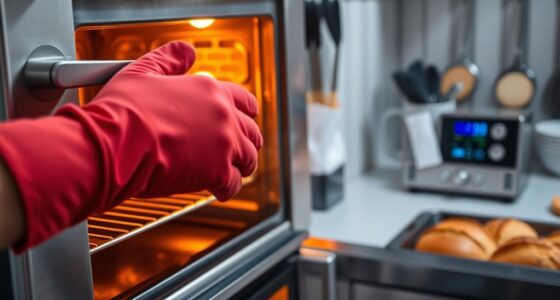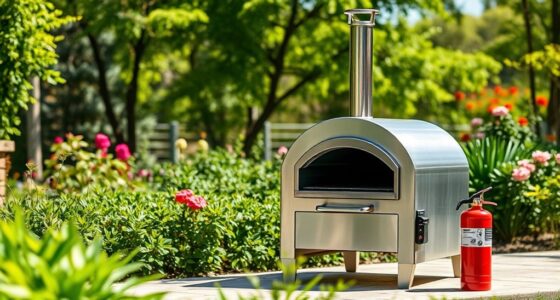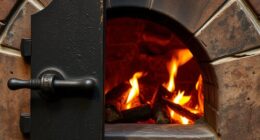If you’re looking for better protection, fireproof gloves are the way to go. They’re made from advanced heat-resistant materials like Kevlar or Nomex, allowing them to withstand direct flames and extremely hot surfaces. Oven mitts offer decent insulation but are better suited for moderate heat tasks. For high-temperature environments or handling open flames, fireproof gloves give you greater safety and dexterity. Keep exploring to discover which option best fits your cooking or grilling needs.
Key Takeaways
- Fireproof gloves are made from heat-resistant materials and withstand higher temperatures and direct flames better than oven mitts.
- Oven mitts provide insulation for moderate heat but may not handle extremely hot surfaces or open flames effectively.
- Fireproof gloves offer better grip flexibility and dexterity, enabling safer handling of hot cookware and delicate tasks.
- Oven mitts are bulkier, limiting fine manipulation, whereas fireproof gloves allow for more precise control.
- Overall, fireproof gloves provide superior protection in high-heat, open-flame, or demanding cooking environments.

When it comes to handling hot cookware, choosing the right hand protection can make all the difference. You need gear that not only keeps you safe from burns but also allows you to move comfortably and confidently. Fireproof gloves and oven mitts both aim to protect your hands, but they do so in different ways. Understanding their features, especially regarding heat resistance and grip flexibility, will help you decide which option suits your cooking style best.
Fireproof gloves are typically made from advanced heat-resistant materials like Kevlar, Nomex, or silicone, designed to withstand higher temperatures for longer periods. This means they can handle direct contact with flames or extremely hot surfaces without melting or degrading. Their superior heat resistance makes them ideal for tasks like grilling over open flames or managing hot pots on the stove. However, because they are often constructed with a flexible, glove-like fit, they usually provide better grip flexibility than traditional mitts, allowing you to grasp utensils, pots, and pans with more control. This flexibility is essential when precision matters, such as flipping food or adjusting a hot baking tray.
Made from heat-resistant materials like Kevlar or silicone, fireproof gloves offer superior protection and flexibility for handling hot items.
Oven mitts, on the other hand, are generally made from thick quilted fabric with a heat-resistant lining. They’re designed to insulate your hands from heat, but their heat resistance can vary depending on the material and thickness. While they do a good job of protecting against moderate temperatures, they may not be suitable for handling extremely hot items or direct flames. Their design, however, tends to be bulkier, which can limit grip flexibility. This bulkiness might make it harder to manipulate small or delicate items, and you might find yourself struggling to get a firm hold, especially on slippery surfaces. Still, oven mitts excel at providing consistent insulation against heat, making them reliable for tasks like pulling baked goods out of the oven or handling hot dishes on a countertop.
Ultimately, your choice hinges on what kind of cooking you do most often. If you need versatile protection that offers both heat resistance and dexterity, fireproof gloves might be your best bet. They give you the confidence to handle very hot items safely while maintaining good grip flexibility. If your cooking involves mostly moderate heat and you prefer something simple and straightforward, oven mitts will serve you well, especially if they’re made from high-quality materials. Both options have their strengths, but understanding their differences in heat resistance and grip flexibility ensures you can pick the right hand protection for your needs, keeping your hands safe without sacrificing control.
Frequently Asked Questions
Are Fireproof Gloves More Flexible Than Oven Mitts?
Fireproof gloves are generally more flexible than oven mitts due to their material flexibility, allowing for better dexterity enhancement. You’ll find that gloves made from thinner, more pliable materials enable you to handle hot items more precisely. Oven mitts tend to be bulkier and less flexible, which can limit your movements. So, if you need greater dexterity, fireproof gloves are your better choice for flexibility and fine control.
Can Oven Mitts Withstand Direct Contact With Open Flames?
Oven mitts generally can’t withstand direct contact with open flames due to their limited heat resistance. They’re designed to protect you from hot surfaces, but flame exposure can cause them to melt or burn. If you’re working near open flames, you should opt for fireproof gloves, which are specifically made for flame exposure and offer better protection. Never rely solely on oven mitts when dealing with open flames.
Which Offers Better Grip for Handling Hot Cookware?
Oven mitts generally offer a better grip for handling hot cookware because they provide good heat resistance while allowing you to maintain dexterity. Their padded design helps you grasp objects securely, reducing slips. Fireproof gloves may offer similar heat resistance but often sacrifice dexterity, making it harder to handle delicate or small items. For better grip and control, oven mitts are typically the preferred choice.
Are Fireproof Gloves Suitable for Industrial Kitchen Use?
Yes, fireproof gloves are suitable for industrial kitchen use because they’re made from fireproof material that withstands high heat. They’re designed to meet industrial compliance standards, guaranteeing safety during heavy-duty tasks. You can handle hot equipment and cookware confidently, knowing you’re protected against burns. Just make sure to select gloves that are specifically rated for industrial environments to ensure maximum safety and compliance with safety regulations.
Do Oven Mitts Provide Insulation Against Sudden Heat Surges?
Oven mitts do provide some insulation against sudden heat surges, but their effectiveness depends on heat transfer and thermal conductivity. You feel the warmth gradually, as they slow heat transfer from hot surfaces to your skin. However, they aren’t designed for extreme heat or rapid temperature changes. To stay safe, choose mitts with low thermal conductivity, which better insulate against sudden heat surges and protect your hands from burns.
Conclusion
When choosing between fireproof gloves and oven mitts, think of fireproof gloves as your armor and oven mitts as your cozy blanket. Fireproof gloves offer better dexterity and protection for handling hot, sharp objects, while oven mitts provide a thick layer of insulation for general oven use. Ultimately, pick what suits your needs best—like choosing the right tool for the job. Both are essential, but fireproof gloves are like a knight’s shield, ready for battle.









